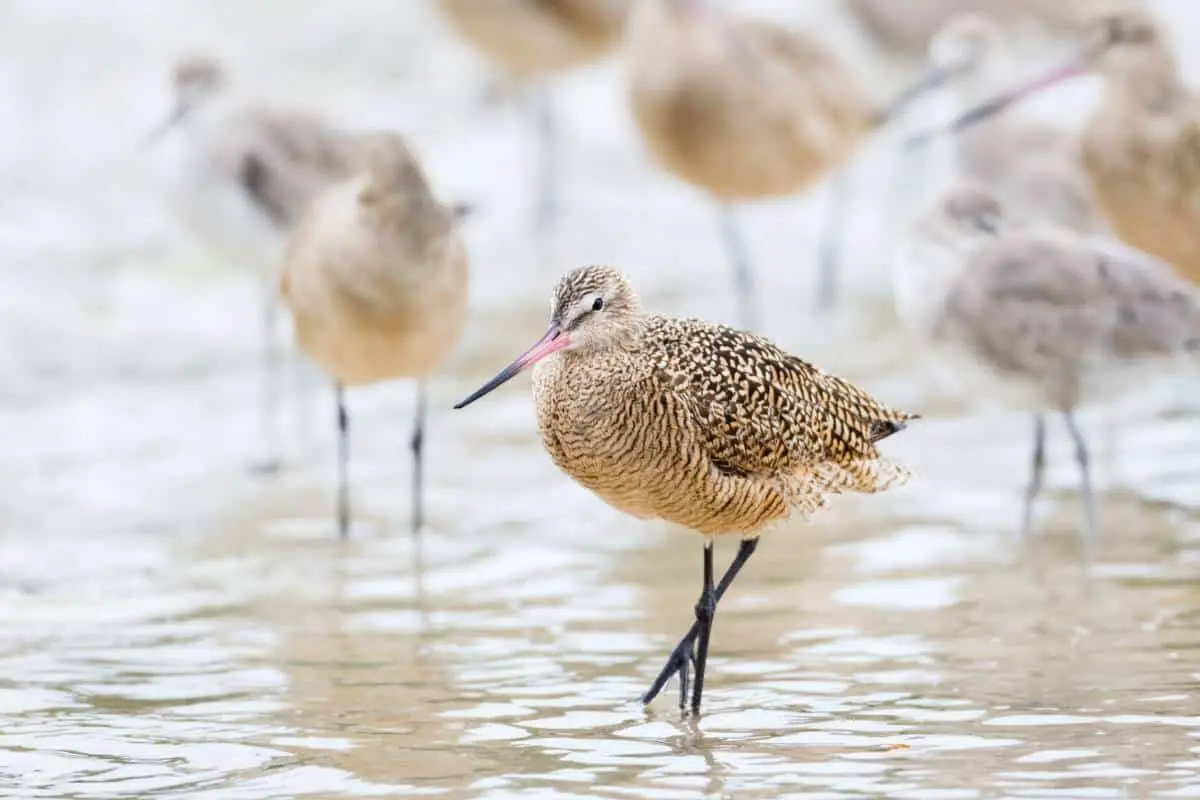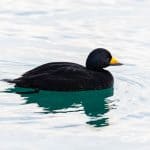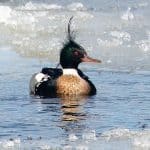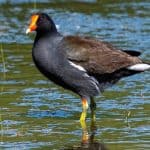Common Name: Marbled Godwit
Scientific Name: Limosa fedoa| Size | Diet | Range in Hawaii | Status in Hawaii |
|---|---|---|---|
| 18 in. - 20 in. | insects, crustaceans, mollusks, and worms | Unknown | Least Concern |
The Marbled Godwit, also known as Limosa fedoa, is a stunning bird that is known for its unique and distinctive appearance. These wading birds are found throughout North America, from Alaska to Mexico. But did you know that the Marbled Godwit can also be found in Hawaii? That’s right! While not a common sight, some Marbled Godwits have been known to make their way to Hawaii during their migratory journey.
In this article, we’ll take a closer look at the fascinating characteristics and behaviors of the Marbled Godwit and learn more about its presence in the beautiful islands of Hawaii.
Marbled Godwit
Appearance
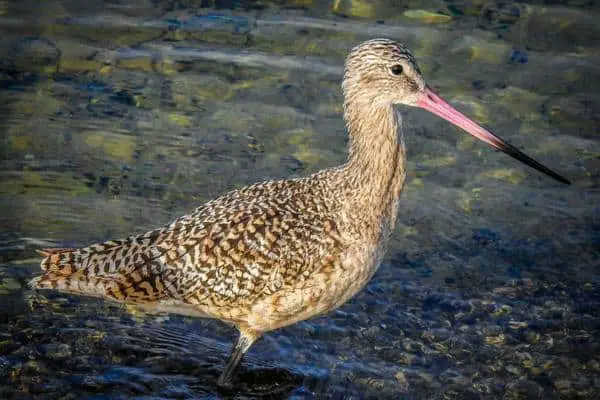
The Marbled Godwit is a large shorebird with a distinctive appearance. It has a long, slightly upturned bill that is pinkish-gray in color, allowing it to probe deep into the mud and sand in search of prey.
The bird has a mottled brown and buff plumage, with intricate patterns and streaks on its upperparts. Its underparts are pale with subtle barring. During flight, the Marbled Godwit displays a bold white wing stripe, which is visible against its darker wings.
In terms of size, the Marbled Godwit measures approximately 18 to 20 inches (45 to 51 centimeters) in length. It has a wingspan of around 30 to 32 inches (76 to 81 centimeters). These measurements make it a relatively large shorebird, further enhancing its distinctive appearance in its coastal habitats.
Diet
The Marbled Godwit is a large shorebird that feeds primarily on invertebrates, including insects, crustaceans, mollusks, and worms. They use their long, sword-like bills to probe deep into the sand and mud to extract prey. During the breeding season, Marbled Godwits also consume plant material, such as seeds and tubers, to supplement their diet. They forage in a variety of habitats, including coastal mudflats, estuaries, and grasslands, and are known to fly long distances to find suitable feeding areas.
Nesting
The Marbled Godwit constructs its nests in the open grassy areas of its breeding range, which includes Alaska, the prairie region of Canada, and the northern central United States. The nest is a shallow depression in the ground, lined with grasses and other vegetation.
The female Marbled Godwit takes the primary responsibility for incubating the eggs, typically laying a clutch of four eggs. Both parents take turns incubating the eggs for about three to four weeks until they hatch.
Once the chicks emerge, they are precocial and capable of leaving the nest shortly after hatching. The parents provide care and protection to the young, guiding them to suitable foraging areas and defending them from potential threats.
The Marbled Godwit’s nesting behavior is an essential part of its breeding cycle, contributing to the survival and growth of the species.
Behavior
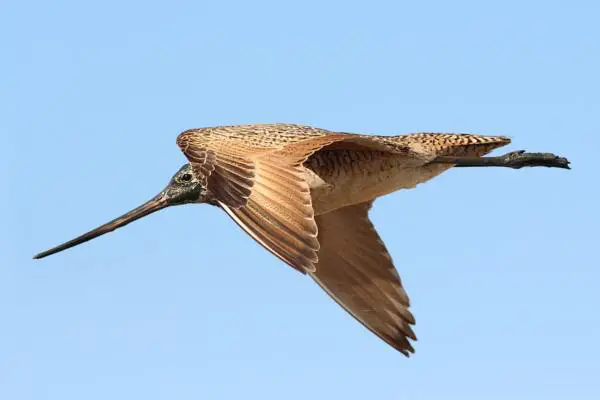
The Marbled Godwit displays several interesting behaviors throughout its life cycle. During the breeding season, males engage in elaborate courtship displays, including aerial displays, vocalizations, and territorial behavior, to attract females. Once paired, the godwits engage in monogamous relationships for the duration of the breeding season.
One notable behavior of the Marbled Godwit is its long-distance migration. It undertakes remarkable journeys from its breeding grounds in Alaska and Canada to its wintering areas along the Pacific coast of North America, occasionally extending to South America. These migrations can span thousands of miles, and the godwits rely on their impressive endurance and navigational skills to find suitable habitats along their migratory routes.
When foraging, Marbled Godwits use their long, slender bills to probe deep into the mud or soil in search of prey. They primarily feed on small invertebrates such as worms, insects, crustaceans, and mollusks. Their bill’s sensitive tip allows them to detect and capture prey hidden beneath the surface, making them effective foragers in coastal wetlands, mudflats, and grassy habitats.
During the non-breeding season, Marbled Godwits are often found in loose flocks, foraging and resting together. They maintain a social hierarchy within these groups, with dominant individuals gaining better access to food resources and prime resting spots.
In terms of vocalizations, Marbled Godwits emit a variety of calls, including soft, flute-like whistles and sharper alarm calls when threatened. These vocalizations help individuals communicate with each other, establish territory boundaries, and maintain group cohesion.
Habitat
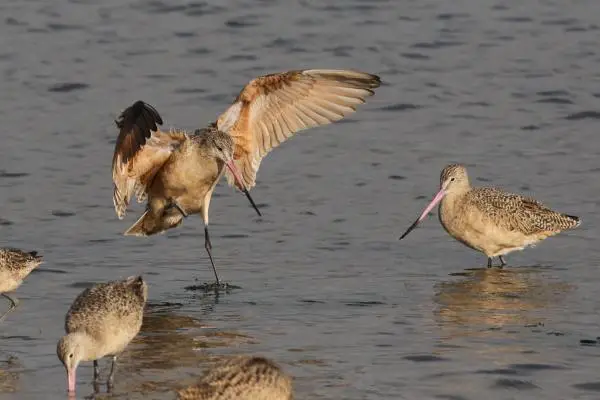
The Marbled Godwit is a species that occupies a range of diverse habitats throughout its lifecycle. During the breeding season, these birds are found in the prairie regions of Canada and the northern United States, as well as in parts of Alaska.
They prefer nesting in grassy areas near wetlands, marshes, or shallow freshwater lakes. Outside of the breeding season, Marbled Godwits undertake long-distance migrations to their wintering grounds along the Pacific coast of North America, extending from southern Alaska down to Mexico.
These coastal habitats include tidal flats, mudflats, estuaries, and sandy beaches, which provide an abundant supply of invertebrates for the godwits to feed on. During migration, the Marbled Godwits may also make stopovers in other suitable habitats, such as flooded fields, agricultural lands, and coastal lagoons. They rely on these areas to rest and refuel before continuing their journey.
Range
The Marbled Godwit is a rare vagrant to Hawaii, with only three substantiated records of individuals on the islands. The first record was of a male collected on Laysan Island in 1966, and another individual, likely a female, was found in several locations in Hawaii in 2004-2006. The range of the Marbled Godwit in Hawaii is limited to these few individuals, and it is not known to breed or winter in the islands.
Conservation Status
The Marbled Godwit is currently listed as a species of “Least Concern” on the IUCN Red List. While there is no immediate threat to its overall population, certain factors can impact the species locally. Loss and degradation of wetland habitats, including the conversion of wetlands for agriculture or development, pose a significant threat to the Marbled Godwit’s breeding and foraging areas.
Interesting Facts
1. Long-distance migrant
Marbled Godwits undertake remarkable long-distance migrations. Breeding in the northern parts of North America, they travel thousands of miles south to their wintering grounds along the Pacific coast of North and South America.
2. Aggressive defenders
Marbled Godwits are known for their defensive behavior, especially during the breeding season. They vigorously defend their nests by engaging in aerial displays, vocalizations, and even physical attacks on intruders that venture too close.
3.Partners for life
Marbled Godwits are monogamous birds, and pairs typically mate for life. They often return to the same breeding sites year after year, reaffirming their bond and strengthening their nesting territories.
4.Distinctive call
During the breeding season, male Marbled Godwits produce a distinctive and melodious “chip-it” call, which they use to communicate with their mates and defend their territory.
5. Unique bill
The Marbled Godwit has a long, slightly upturned bill that is pink at the base and gradually darkens towards the tip. It is specially adapted for probing and foraging in the mudflats and marshes where it feeds.
Frequently Asked Questions
1. How long do Marbled Godwits live?
Marbled Godwits can live up to 15 years or more, with some individuals known to have reached over 20 years of age.
2. Are Marbled Godwits territorial?
Yes, Marbled Godwits defend their nesting territories during the breeding season. They display aggressive behaviors towards intruders, including aerial chases and vocalizations, to protect their nesting sites and offspring.
3. Do Marbled Godwits form mixed-species flocks?
Marbled Godwits are often found in mixed-species flocks with other shorebirds during migration and wintering periods. These flocks provide safety in numbers and enhance foraging efficiency.
